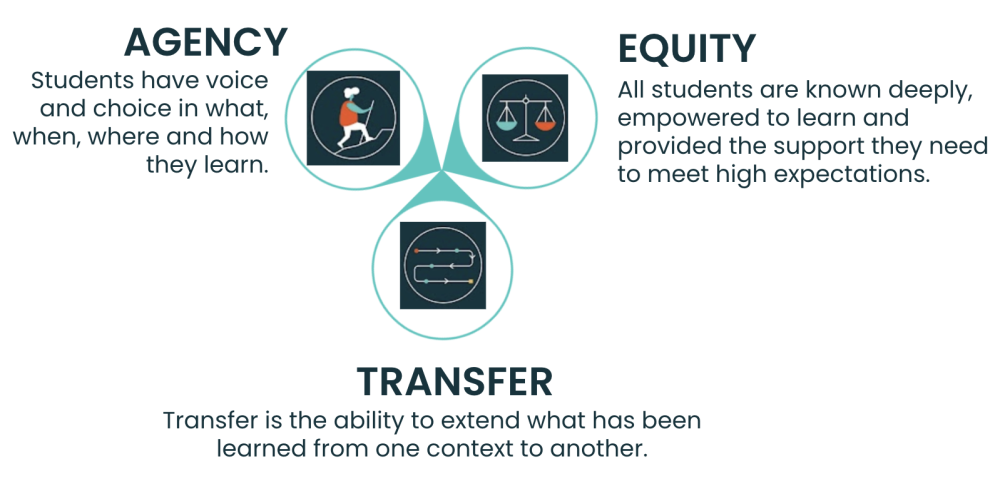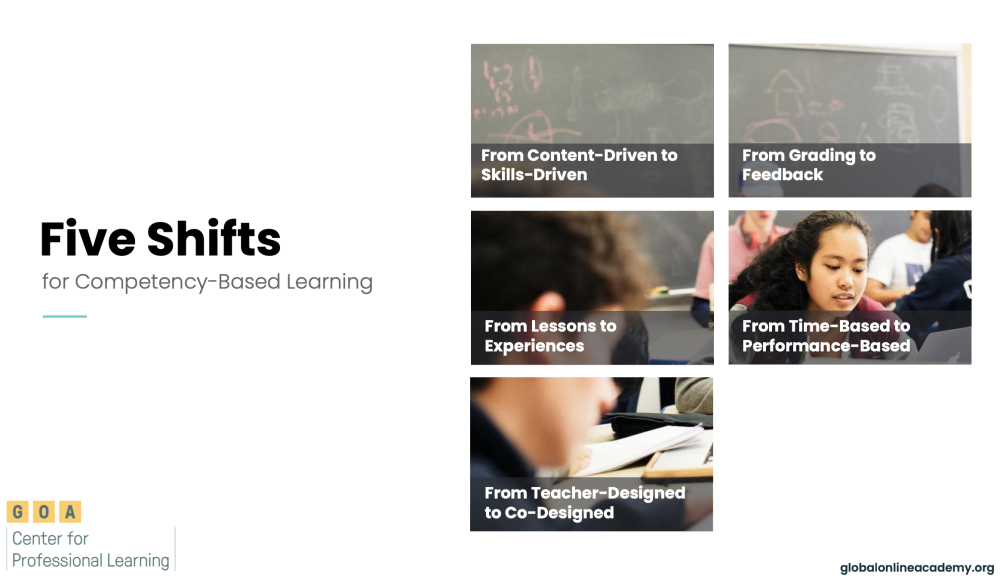What Is Competency-Based Learning and Why It Matters
In recent years, there’s been a growing interest in reimagining educational systems to better serve students. This evolution in thinking has highlighted competency-based learning (CBL), a model also known as mastery or proficiency-based learning. Unlike traditional systems that ask students to conform to a set structure, CBL adapts to individual students, offering a more personalized and meaningful learning experience. At GOA, we believe in CBL's potential to transform the educational landscape. But what exactly is CBL, and why does it matter?
What CBL Is (and Is Not)
Competency-based learning is more than just an educational buzzword. It's a comprehensive system that aims to mirror how people learn, work, and succeed in the world. Built around evidence-based assessment, a CBL approach promotes shifts in teacher practice that ensures students have the opportunity to apply what they’re learning to develop critical, transferable skills. But what does this look like in practice?
To help educators and schools understand and implement CBL, the Aurora Institute has outlined seven core elements of CBL:
Students are empowered daily to make important decisions about their learning experiences, how they will create and apply knowledge, and how they will demonstrate their learning.
Assessment is a meaningful, positive, and empowering learning experience for students that yields timely, relevant, and actionable evidence.
Students receive timely, differentiated support based on their individual learning needs.
Students progress based on evidence of mastery, not seat time.
Students learn actively using different pathways and varied pacing.
Strategies to ensure equity for all students are embedded in the culture, structure, and pedagogy of schools and education systems.
Rigorous, common expectations for learning (knowledge, skills, and dispositions) are explicit, transparent, measurable, and transferable.
These elements work together to create a learning environment that adapts to individual students, rather than expecting students to conform to a rigid system. It's important to understand that CBL isn't about learning skills instead of content. Rather, it's about learning critical skills that empower learners to engage with content more deeply, meaningfully, and productively. CBL is also not about eliminating grades, but rather shifting assessment practices to ensure they are practical and relevant and that students have multiple opportunities to show evidence of skill mastery. CBL differs from standards-based education by emphasizing personalized, equitable practices that meet students where they are.
"What excites me most about CBL is how it empowers students to take ownership of their learning journey," says Director of Student Programs Jason Cummings. "We're not just teaching content; we're cultivating critical thinkers, problem-solvers, and self-directed learners who are ready to tackle the challenges of the 21st century."
Ultimately, CBL is a flexible, student-centered approach that recognizes each learner's unique journey while maintaining high standards for all.
Why CBL Matters

In today's rapidly changing world, traditional educational models are increasingly falling short. CBL offers a solution that addresses many of the challenges faced by students, educators, and schools. Here's why CBL matters:
It Promotes Student Agency: CBL empowers students to have voice and choice in what, when, where, and how they learn. This ownership of learning is crucial in a world where the ability to adapt and learn continuously is invaluable. By fostering agency, CBL prepares students to be lifelong learners, capable of navigating the complexities of the 21st century.
It Enhances Equity: CBL ensures that all students are known deeply, empowered to learn, and provided with the support they need to meet high expectations. It's an approach that redesigns systems to celebrate individual students and address systemic barriers. By allowing students to progress based on mastery rather than time, CBL helps level the playing field and gives every student the opportunity to succeed.
It Facilitates Transfer of Learning: CBL focuses on developing the ability to extend what has been learned from one context to another. This includes essential non-cognitive skills like empathy, self-regulation, and purpose, which are critical for success both in and beyond school. By emphasizing transfer, CBL ensures that learning is not just about passing tests, but about developing skills and knowledge that students can apply in real-world situations.
CBL matters because it aligns education with the needs of today's learners and the demands of our rapidly evolving world. It transforms education from a one-size-fits-all model to a flexible, personalized experience that prepares students not just for exams, but for life.
The Path to CBL

At GOA, we believe transitioning to CBL involves five key shifts in how we approach education. These shifts are not a rigid roadmap but rather flexible pathways that schools can adapt based on their unique contexts, strengths, and areas for growth. There's no one-size-fits-all approach or prescribed order for implementation. Instead, schools often find success by leveraging their existing strengths and addressing their most pressing needs first.
Here are the five key shifts, along with examples of how schools might begin to implement them:
From Content-Driven to Skills-Driven: CBL is about reprioritizing, not replacing content with skills. It focuses on what it means to think and act like an expert in the field, emphasizing skills that have transfer potential beyond the classroom.
From Grading to Feedback: CBL emphasizes meaningful feedback over simple grades. This includes creating a feedback ecosystem that incorporates teacher-student feedback, peer feedback, self-assessment, and more.
From Time-Based to Performance-Based: CBL recognizes that students learn at different paces. It involves designing pacing guides, creating content playlists, and valuing mastery over speed.
From Lessons to Experiences: CBL emphasizes creating relevant, engaging learning experiences that connect to students' daily lives and experiences.
From Educator-Designed to Co-Designed: CBL promotes student agency by involving students in the design of their learning experiences.
Whether you're just beginning to explore CBL or you're looking to enhance your current educational practices, GOA is here to support you. Visit our professional learning offerings to learn more about how our partnerships, workshops, and courses can help you bring CBL to your school.
GOA serves students, teachers, and leaders and is comprised of member schools from around the world, including independent, international, charter, and public schools. Learn more about Becoming a Member. Our professional learning opportunities are open to any educator or school team. Follow us on LinkedIn. To stay up to date on GOA learning opportunities, sign up for our newsletter.
